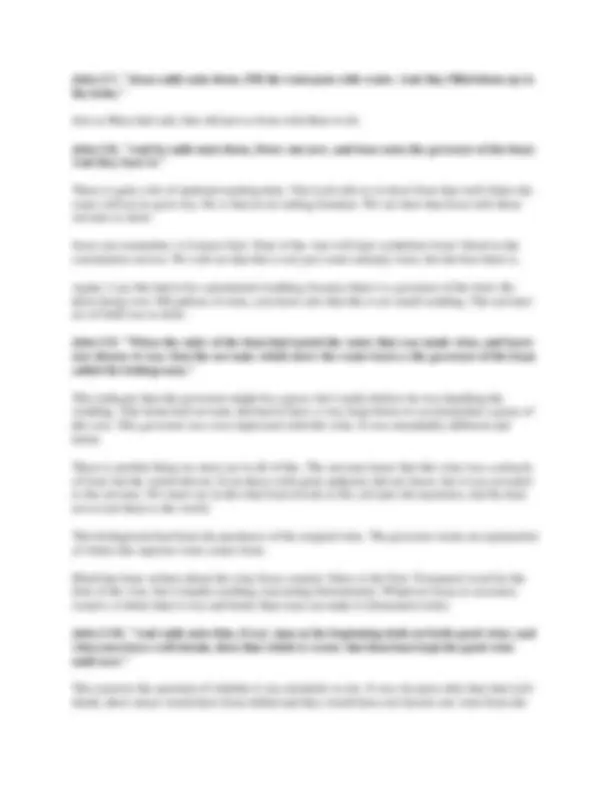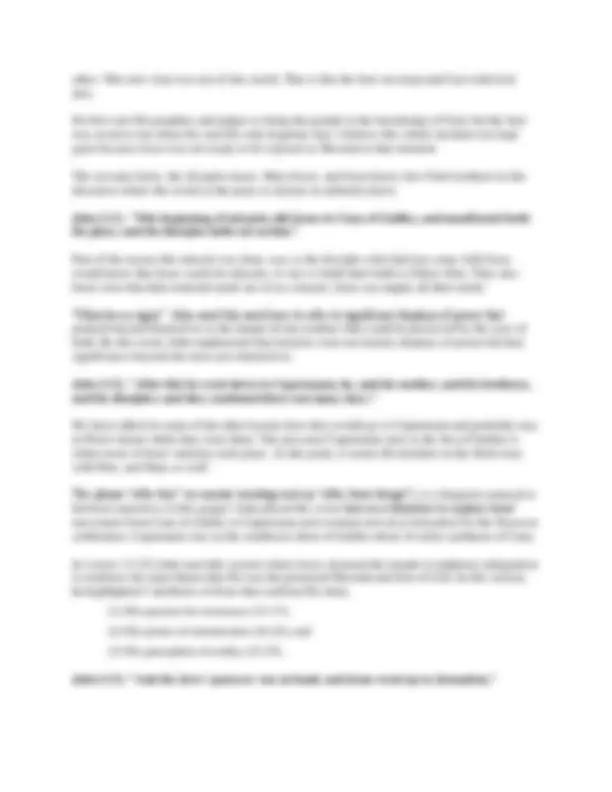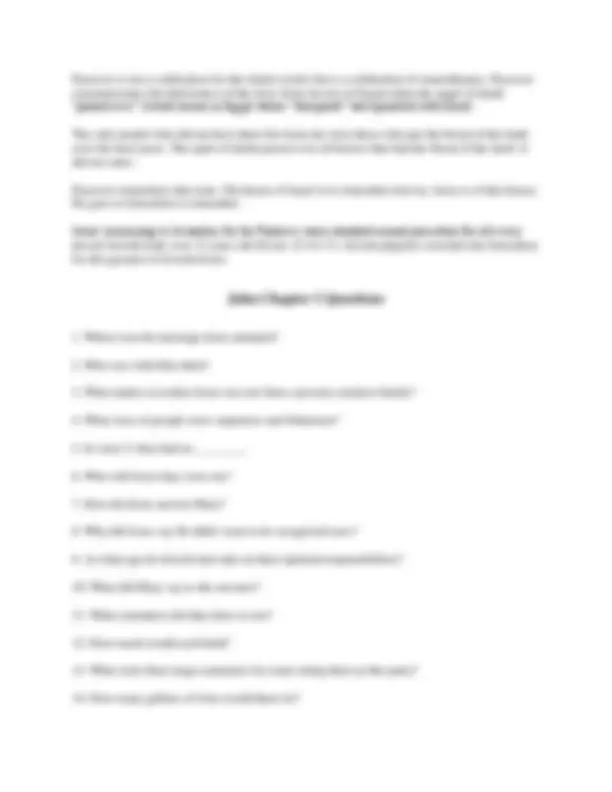





Study with the several resources on Docsity

Earn points by helping other students or get them with a premium plan


Prepare for your exams
Study with the several resources on Docsity

Earn points to download
Earn points by helping other students or get them with a premium plan
Community
Ask the community for help and clear up your study doubts
Discover the best universities in your country according to Docsity users
Free resources
Download our free guides on studying techniques, anxiety management strategies, and thesis advice from Docsity tutors
The first miracle performed by Jesus at a wedding in Cana of Galilee, where he turned water into wine. the significance of this event, the context of the Jewish wedding, and the reactions of those present. It also touches upon the importance of obedience and faith in experiencing miracles.
Typology: Summaries
1 / 6

This page cannot be seen from the preview
Don't miss anything!




John relates the first great sign performed by Jesus to demonstrate His deity, the turning of water into wine. Only God can create from nothing. John identifies 8 miracles in his gospel that constitute “signs” or confirmation of who Jesus is. Each of the 8 miracles were different, no two were alike. John 2:1-2, "And the third day there was a marriage in Cana of Galilee; and the mother of Jesus was there:" "And both Jesus was called, and his disciples, to the marriage." This third day speaks of the third day in Jesus' gathering of His disciples. It is interesting to note that Jesus' mother, Jesus, and the disciples would be invited to this type of wedding. This is obviously a Jewish wedding and sometimes they lasted seven to fourteen days. It was a very festive occasion. These have to be prominent people in the community to have this large of a wedding. The guests as well, would be people who were upper-middle class to upper class as far as financial standing in the community went. Carpenters would fall into that category in those days and so would fishermen who owned their own boats. Both occupations were honorable. This is not a poverty-stricken group at this wedding. Some would think, why would Jesus waste His time going to such an affair? Marriage the Bible says, is honorable. This couple was following God's teaching in getting married. Jesus also loved people and this would show His concern for all things His people on earth are involved in. After Jesus became an adult, there is very little shown in contact with His mother Mary. Perhaps this wedding was family or close friends. We are not told those details. Possibly, word had already travelled about Jesus' baptism. At any rate, Jesus and His disciples were invited to this wedding. The disciples who accompanied Him are the 5 mentioned in chapter 1: Andrew, Simon Peter, Philip, Nathanael and the unnamed disciple who was surely John, who also witnessed this miracle. John 2:3, "And when they wanted wine, the mother of Jesus saith unto him, They have no wine." This tells me that Mary knows that Jesus does miracles. This is the first recorded miracle, but that does not mean that Jesus had not done miracles earlier. I feel sure that when a crisis arose in their neighborhood, Mary had seen Jesus taking care of it. We know for sure that Mary expects Jesus to do something about this situation.
This seems like such a trivial thing but we must remember that this host will be terribly embarrassed if they run out of wine. Jesus cares for our trivial needs, as well as our great big needs. Because of a lack of water purification, wine mixed with water was safer to drink than water alone. While the bible condemns drunkenness, it does not necessarily condemn the consumption of wine. (Psalm 104:15, Prov. 20:1). John 2:4, "Jesus saith unto her, Woman, what have I to do with thee? mine hour is not yet come." I do not believe Jesus is harsh to His mother here but it does have the effect of distancing Jesus from His mother and her request. I believe He is saying, "I am not quite ready to launch into the miracles at this time". It isn't time yet. There were stages in Jesus' life on earth. He had spent a time subject to His mother and Joseph. Now He is thirty years old, the time when Jewish men take on their spiritual responsibilities. He is old enough now and is on His own. Jesus possibly does not want this miracle at this large gathering at the wedding to thrust Him into His period of popularity. He possibly would rather that would come a short time later from His sermons. Nevertheless, Jesus listens to Mary and has feelings for the host. Mine hour is not yet come is a phrase constantly referring to Jesus’ death and exaltation. He was on a divine schedule decreed by God before the foundations of the world. John 2:5, "His mother saith unto the servants, Whatsoever he saith unto you, do it." This in itself is a giveaway that Mary knows about Jesus' miraculous ability. Now is no different than then. Miracles in our lives will not come until we are obedient to Jesus. John 2:6, "And there were set there six waterpots of stone, after the manner of the purifying of the Jews, containing two or three firkins apiece." A firkin is nine gallons. Each one of these water pots had from eighteen to twenty-seven gallons each. There were somewhere between 108 gallons and 162 gallons of water here. This had to be for a large group of people. The pots were made of stone because stone was more impervious that earthenware and did not contract uncleanness. The washings or ablutions had extended to such an extent that they were continuously washing for one reason or the other, and these six firkins of water were standing by for them to carry on these ceremonial washings with.
other. This new wine was not of this world. This is like the best was kept until last with God also. He first sent His prophets and judges to bring the people to the knowledge of God, but the best was saved to last when He sent His only begotten Son. I believe this whole incident was kept quiet because Jesus was not ready to be exposed as Messiah at that moment. The servants knew, the disciples knew, Mary knew, and Jesus knew, but I find nowhere in this discourse where the crowd at the party or anyone in authority knew. John 2:11, "This beginning of miracles did Jesus in Cana of Galilee, and manifested forth his glory; and his disciples believed on him." Part of the reason this miracle was done, was so the disciples who had just come with Jesus would know that Jesus could do miracles. It was to build their faith to follow Him. They also know now that their material needs are of no concern; Jesus can supply all their needs. “Miracles or signs”: John used this word here to refer to significant displays of power that pointed beyond themselves to the deeper divine realities that could be perceived by the eyes of faith. By this word, John emphasized that miracles were not merely displays of power but had significance beyond the mere acts themselves. John 2:12, "After this he went down to Capernaum, he, and his mother, and his brethren, and his disciples: and they continued there not many days." We have talked in some of the other lessons how they would go to Capernaum and probably stay in Peter's house while they were there. The area near Capernaum next to the Sea of Galilee is where most of Jesus' ministry took place. At this point, it seems His brothers in the flesh were with Him, and Mary as well. The phrase “after this” (or similar wording such as “after these things”), is a frequent connective between narratives in this gospel. John placed this verse here as a transition to explain Jesus’ movement from Cana in Galilee to Capernaum and eventual arrival at Jerusalem for the Passover celebration. Capernaum was on the northwest shore of Galilee about 16 miles northeast of Cana. In (verses 13- 25 ) John used this section where Jesus cleansed the temple in righteous indignation to reinforce his main theme that He was the promised Messiah and Son of God. In this section, he highlighted 3 attributes of Jesus that confirm His deity: (1) His passion for reverence ( 13 - 17); (2) His power of resurrection (18-22); and (3) His perception of reality ( 23 - 25). John 2:13, "And the Jews' passover was at hand, and Jesus went up to Jerusalem,"
Passover is not a celebration for the whole world, but is a celebration of remembrance. Passover commemorates the deliverance of the Jews from slavery in Egypt when the angel of death “passed over” Jewish homes in Egypt whose “doorposts” was sprinkled with blood. The only people who did not have their first born die were those who put the blood of the lamb over the door posts. The spirit of death passed over all houses that had the blood of the lamb. It did not enter. Passover remembers that time. The house of Israel is to remember forever. Jesus is of this house; He goes to Jerusalem to remember. Jesus’ journeying to Jerusalem for the Passover was a standard annual procedure for all every devout Jewish male over 12 years old (Exod. 23:14-17). Jewish pilgrims crowded into Jerusalem for this greatest of Jewish feasts.